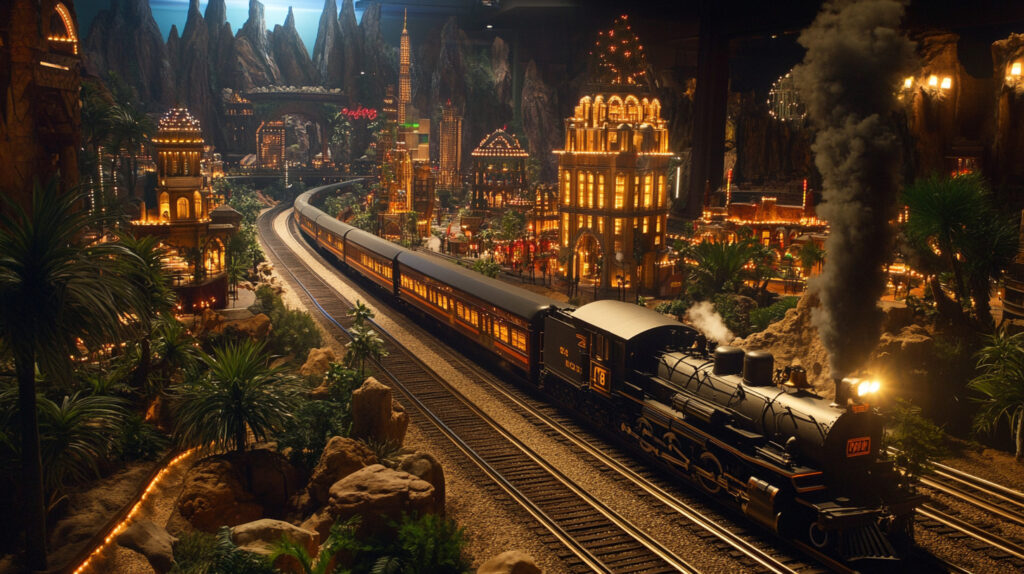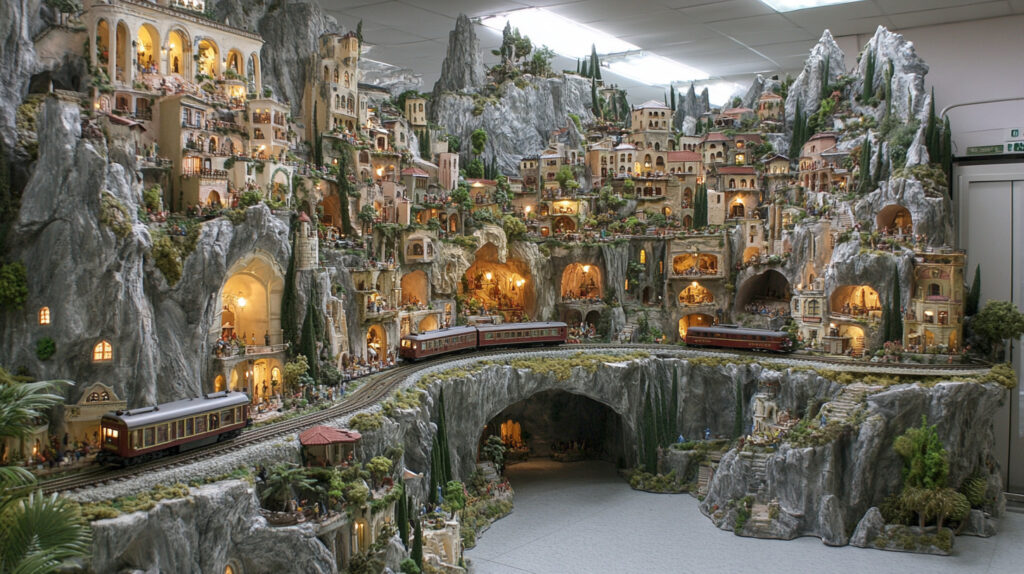Imagine a bustling train station nestled inside a vintage suitcase, or a mountain pass carved into the surface of a coffee table. Welcome to the universe of small model railways—where meticulous craftsmanship meets boundless creativity, all within the confines of compact spaces.
Forget sprawling basements or garage-sized dioramas; today’s hobbyists are redefining what’s possible with layouts so small they fit on a bookshelf yet burst with jaw-dropping detail.
Whether you’re a seasoned modeler craving a fresh challenge or a newcomer daunted by the perceived scale of traditional setups, micro layouts offer a thrilling entry point. Let’s unpack how these tiny marvels are revolutionizing the hobby—and how you can build your own.
Want to build your dream model railroad? Download my FREE guide

Privacy Policy: We hate SPAM and promise to keep your email address safe
Why Go Small? The Allure of Micro Model Railways
Space constraints often deter aspiring model railroaders, but micro layouts flip this obstacle into an opportunity. By focusing on a single scene or a minimalist loop, these designs prioritize quality over quantity, inviting you to hone your skills in scenery, electronics, and storytelling.
- Cost Efficiency: Smaller scales mean fewer materials—less track, fewer buildings, and lower expenses overall. A basic Z-scale setup can cost under $200, compared to thousands for larger gauges. Read my guide on spending money for your model train layouts to learn more
- Portability: Imagine displaying your layout at a local hobby show or storing it under the bed. Micro models are as mobile as they are mesmerizing.
- Creative Focus: With limited real estate, every element must earn its place. This forces clever design choices, like using forced perspective to simulate depth or repurposing everyday objects as scenery.
As master modeler Carl Smith once quipped, “A micro layout isn’t about what you can’t include—it’s about perfecting what you do.”
Choosing Your Scale: A Guide to Tiny Trains
Not all small scales are created equal. Here’s a breakdown of the most popular options for micro layouts:
| Scale | Ratio | Minimum Layout Size | Detail Level | Best For |
|---|---|---|---|---|
| T Scale | 1:450 | 12” x 6” | Basic shapes, minimal | Experimental projects |
| Z Scale | 1:220 | 24” x 12” | Moderate, factory-painted | Realistic landscapes |
| N Scale | 1:160 | 36” x 18” | High, customizable | Detailed urban or rural scenes |
T Scale (1:450): Pioneered by brands like Tomytec, this is the smallest commercially available scale. Trains are about the size of a paperclip, making them ideal for dioramas inside shadow boxes or desk ornaments. However, detail is minimal, and customization requires patience.
Z Scale (1:220): A sweet spot for many micro enthusiasts, Z-scale trains from manufacturers like Marklin balance detail with compactness. You can create a functional oval track in just 24 inches, complete with tunnels and bridges.
N Scale (1:160): The largest of the “small” scales, N scale offers intricate locomotives and scenery kits from brands like Kato USA. It’s perfect for hobbyists who want to incorporate features like working streetlights or animated figures.
Designing for Compact Spaces: Pro Tips
1. Think Vertical
Maximize every cubic inch by building upward. A layered design with cliffs, overpasses, or stacked buildings adds drama without expanding the footprint. The award-winning “Alpine Escape” layout crams a waterfall, village, and spiral tunnel into a 30” x 18” space by using tiered platforms.
2. Embrace Selective Compression
Replicate the essence of a real location without replicating every inch. For example, I modeled just the facade of a train station and condensed a mile-long stretch of track into a serpentine curve. I did this with the N gauge trains without any problems.

3. Create a Focal Point
Draw the eye to one standout feature—a weathered barn, a glowing station, or a trestle bridge. Surround it with simpler elements to avoid visual clutter.
4. Use Forced Perspective
Place smaller-scale figures or trees in the background to simulate distance. This trick adds depth to even the flattest layouts. I love to get creative with my scenery pieces, and I tend to build them DIY style. This takes a lot of time, but you can cut corners once you get better at crafting train scenery pieces.
Tools of the Trade: Building Your Micro Empire
You don’t need a workshop full of gear to start, but these essentials will set you up for success:
- Precision Tools: Invest in fine tweezers, a magnifying visor, and a razor saw for cutting miniature parts.
- Flexible Track Systems: Brands like Micro Engineering offer pre-curved Z-scale tracks that simplify setup.
- Scenery Kits: Look for laser-cut wood kits from Scale Scenes or 3D-printed accessories on Shapeways.
- Lighting: Micro LED strips from Evans Designs can illuminate buildings or streetlights without overheating.
Case Studies: Micro Layouts That Inspire
The Teacup Railway
Built inside a repurposed serving tray, this T-scale layout features a cherry blossom-lined loop around a porcelain village. The creator used nail art stickers for floral details and a smartphone battery to power the train.
The Bookshelf Express
A Z-scale diorama disguised as a row of hardcover books. Pulling a faux book spine reveals a hidden canyon with a running train. The design cleverly uses the bookshelf’s depth for tunnel portals.

Your First Micro Layout: A 5-Step Blueprint
- Sketch Your Vision: Draft a rough plan, noting key elements like track routes and scenery.
- Build the Base: Use lightweight materials like foam board or plywood.
- Lay the Track: Secure flexible tracks with adhesive caulk for easy adjustments.
- Add Scenery: Start with a base layer of turf or gravel, then build up textures.
- Detail with Purpose: Populate your scene with 2-3 eye-catching features—a parked truck, a flickering campfire, or a grazing cow.
I expanded on each of these points in my guide on getting started with your model train hobby.
FAQ
While costs vary based on scale and complexity, a basic Z-scale starter kit—including a locomotive, two cars, and an oval track—runs between 150−250. Scenery materials like foam, paint, and miniature trees add another 50−100. For budget-friendly builds, repurpose household items: use baking soda for snow, tea leaves for ground cover, or smartphone apps to simulate ambient sounds.
Z-scale (1:220) strikes the ideal balance between detail and manageability. Its trains are small enough to fit intricate layouts in tight spaces but large enough to handle without specialized tools. N-scale (1:160) is another strong option if you prioritize customization, as parts are widely available from retailers like Kato USA. Avoid T-scale (1:450) until you’re comfortable working with ultra-fine components.
Yes, but it requires smart planning. Use automated block systems or DCC (Digital Command Control) to manage separate trains on a single track. Brands like Digitrax offer compact Z-scale DCC systems, though wiring can be challenging in tight spaces. For simplicity, stick to one train and focus on creating a captivating scene around it.
Less is more. Choose 2-3 “hero elements” to anchor your scene—a weathered train depot, a forested hillside, or a detailed bridge. Use subtle textures (e.g., static grass or fine gravel) for the remaining areas. Forced perspective tricks, like placing smaller trees in the background, create depth without clutter.
With supervision, yes! Z- and N-scale trains are durable enough for gentle play, though tiny parts pose choking hazards for children under 10. Opt for simple oval tracks and avoid delicate structures.
Ready to Chug Ahead?
Very small model railways prove that size isn’t a barrier to creativity—it’s a catalyst. By embracing constraints, you’ll discover innovative solutions and develop skills that translate to larger projects. So, what’s stopping you? Clear off that side table, order a starter set, and join the growing community of small-scale visionaries.
I spent a lot of time worrying before getting started. Learn from my mistakes by checking out my free eBook below.
Want to build your dream model railroad? Download my FREE guide

Privacy Policy: We hate SPAM and promise to keep your email address safe

